Remember those Dos Equis advertisements featuring the most interesting man in the world? In case you lived under a rock for the last 10 years, the beer brand put out a brilliant line of commercials featuring a can-do Renaissance man capable of accomplishing myriad masterful feats. It featured lines hilarious like, “In a past life, he was himself,” and “If opportunity knocks, and he’s not home, opportunity waits.”
While the MLB has had no trouble growing the game over the last decade, its brand image could use a little freshening up among the younger generation. A Dos Equis-style ad campaign might do the trick, and luckily for commissioner Rob Manfred, baseball doesn’t need to look far for their most interesting man. That honor unequivocally goes to current Texas Rangers 1B/OF Joey Gallo.
Why Gallo? Well, he is quite simply one of the most unique players to ever don an MLB uniform. Over his first two full MLB seasons, the 25-year old Gallo is second in the league in home runs per at-bat and leads the league in hard-hit rate, strikeouts, and swinging strike rate. He’s also ninth in walk rate and first in three-true-outcome percentage (the rate at which plate appearances end in either a strikeout, walk, or home run—TTO). In fact, Gallo is first all-time in TTO rate at 58.4%, edging second-place Ed Whiting, some guy who played in the 1880s! And if that weren’t enough, Gallo’s hulking 6’5″, 235-pound frame logged at least 15 games at five different positions over the past two seasons, making him baseball’s first utility-man slugger.
Gallo’s inclination toward strikeouts and home runs has drawn the ire of many, especially old-school baseball fans who can’t fathom a player striking out more than one-third of the time. Yet Gallo’s approach has worked. He’s posted above-average overall offensive production in his 23- and 24-year-old seasons, which is no small feat considering most players are still toiling in the minors at the same age. Gallo’s 81 home runs over the last two years are tied for 9th all-time among players in the same age bracket, next to names like Alex Rodriguez, Mark McGwire, and Vladimir Guerrero.
If Gallo were to continue hitting 40 homers and racking up 200+ strikeouts, he could carve out a nice career, but one that would ultimately have limited upside. However, Gallo, who is still young, has another level to his game. Some small adjustments could make him a perennial All-Star and potentially even deserving of MVP votes, further reaffirming his standing as baseball’s most interesting man.
Hacksaw Ridge
Before delving into the stats on Gallo, it’s important to get a flavor for his approach at the plate. The left-handed hitter sets in an open stance that leads into a fairly sizable leg kick upon pitch delivery. Gallo’s swing plane, especially on low-zone pitches, features a large uppercut, almost resembling a golf swing. This uppercut allows Gallo to get balls in the air, leading to more home runs. However, it also leaves him exposed to whiffing when a pitch type or location surprises him. To put it simply, Gallo goes up there hacking.
The side view exposes additional details about his swing. Gallo’s hands start up high and back and then thrust forward upon hip rotation. He generates a lot of kinetic energy with his swing, as his hip rotation is fast and powerful, and his leg kick enables him to successfully transfer the power from his back leg into the baseball. The element missing from these GIFs is the sheer speed and violence mustered in Gallo’s swing. Not only is his swing long and involved, but it’s also ferocious. This magnifies the benefits in terms of hard-hit fly balls but also accentuates the issues with swinging and missing.
Barreling It Up
MLB Statcast introduced a metric called “barrels” in 2016. Barrels are the cream of the batted-ball crop, comprising 81% of home runs and 19% of doubles and triples. They typically emerge with exit velocities off the bat of 100+ mph and launch angles over 15 degrees, and produced an outstanding .799 batting average and 2.759 slugging percentage in 2018.
Barrels are the prime cuts for hitters, as they are near-automatic extra-base hits. They’re also an important part of the Joey Gallo story because from 2017 to 2018, Gallo hit barrels at a rate 350% higher than the MLB average.
Not only does Gallo damage baseballs at a clip far superior to the average MLB hitter, but he also outshines the other top sluggers in baseball. In a selection including Mike Trout, Bryce Harper, Giancarlo Stanton, Freddie Freeman, and Khris Davis, no player is even in the same zip code as Gallo’s 22.3% barrel rate, represented by “great” contact on the graph below. While Gallo slightly trails Trout, Harper, and Freeman in “good” contact, made up of solid hits and flares, he’s still about even with Stanton and Davis. And to top it off, Gallo also has the lowest rate of weak contact among the group.
Gallo performs so strongly in the barrel department because he produces elite exit velocity off the bat. His 93.9 mph average exit velocity was third in the MLB in 2018, while his 99.7 mph exit velocity on fly balls was second. Combining these velocities with one of the highest launch angles in the game at 21.5 degrees is an elixir engineered for barreling the baseball. This disposition favoring hard, loud contact is why Gallo can produce 40+ home runs despite ending over half of his plate appearances with a strikeout or walk. Gallo’s power isn’t just good or great—it’s elite.
Catching a Whiff
Unfortunately for Gallo, the barrels have come at a stiff price, with a career 38.0% strikeout rate that is higher than any other non-pitcher since the late 1910s. Why does this matter? Well, it turns out that scoring a triple-slash of .000/.000/.000 on nearly 40% of one’s plate appearances neuters performance, and sure enough, Gallo’s career batting average of .203 sits just above the Mendoza line.
The major question for Gallo is if there is room to improve his strikeout rate. After all, he is still young and has shown incremental improvement since his major league debut in 2015. Last season’s strikeout rate of 35.9% was almost a full-point improvement on 2017’s 36.8%, which was head and shoulders above the rates he produced in his various cups of coffee in the previous two years.
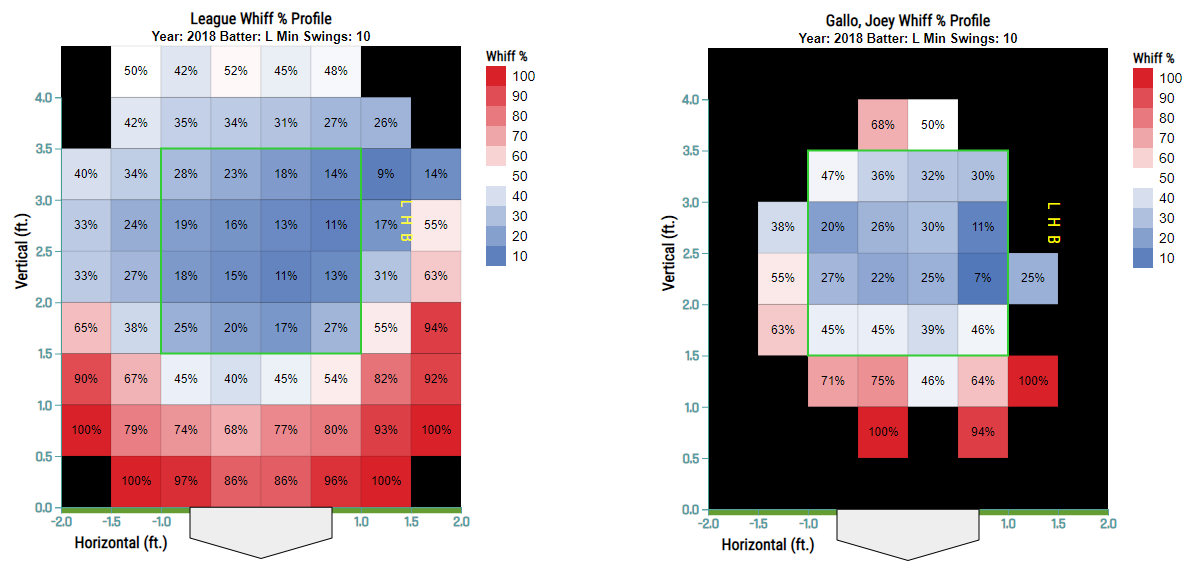
Gallo’s swing mechanics are not indicative of a hitter who will ever show average, or probably even below average, contact skills. When Gallo swung in 2018, he missed 41.0% of the time. The MLB average is 24.0%. What’s more, it’s not as if there a is a specific problem area in the strike zone that Gallo can focus on in terms of lowering his whiff rate. The swings and misses are distributed at well-above-average levels across and outside the strike zone.
There is a good reason for that, though. It turns out that barrels and whiffs are like Jekyll and Hyde—contrasting personalities to a player’s plate approach but ultimately inseparable. Among hitters with at least 300 batted balls between 2017 and 2018, the R2 coefficient between whiff rate and barrel rate was 43%. This indicates that hitting a barrel isn’t just about having a strong and sweet swing. It’s also about an approach at the plate that consciously sacrifices contact for power. If Gallo were to take steps to lower his whiff rate, it would likely lower his barrel rate as well, and who knows if the net outcome would be for better or worse.
Down and Out
Yet there are two components to swinging and missing. Gallo’s 41.0% whiff rate tackles the “missing” part. But what about the swinging component? If Gallo is constrained by his whiff rate, maybe he can lower his strikeout rate by developing better pitch recognition.
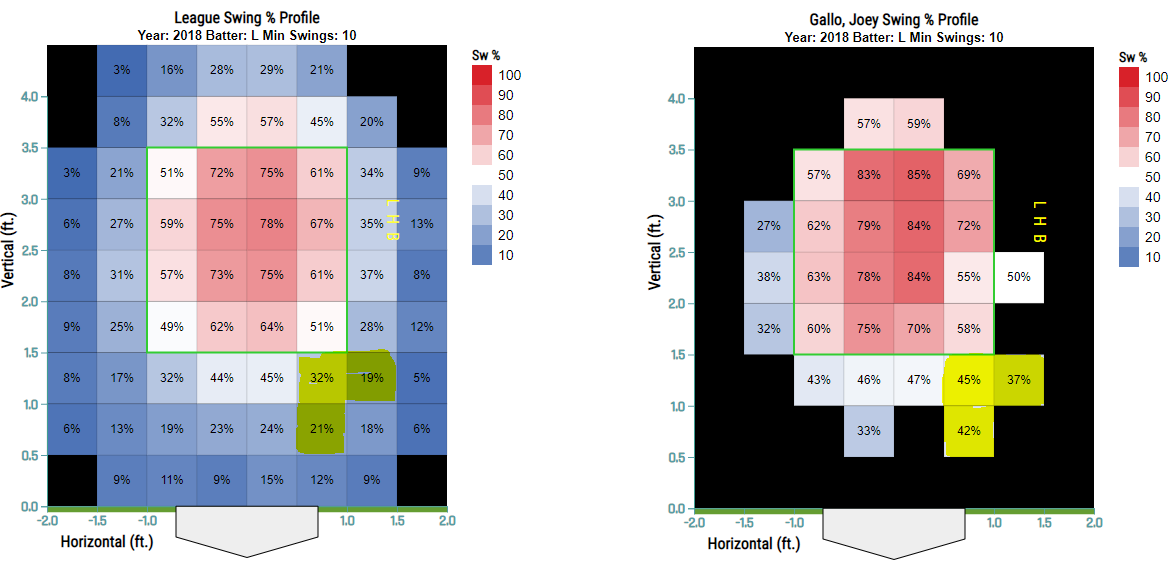
Gallo’s swing rate on pitches directly above and below the strike zone was fairly close to the MLB average in 2018. However, on pitches down and in, highlighted in yellow above, Gallo swings almost twice as much as the average hitter. This is problematic for two reasons—first, these pitches are clearly balls, and second, Gallo whiffs on these swings nearly 100% of the time (cross-reference with the previous whiff chart). These pitch locations are synonymous with sliders and curveballs, which, unsurprisingly, Gallo struggles with most in terms of whiff rate (50%+ for both).
If Gallo were to reduce his swing rates in these zones to the MLB average, he’d convert 15 swings and misses into balls. This alone would lower his whiff rate by a full percentage point. However, there would also be significant secondary benefits. For starters, a lot of the swings in the yellow zones come on two-strike counts, so Gallo would directly avoid strikeouts in certain situations. Moreover, working better counts will lead to more walks and better pitches to hit.
Note there are also other areas outside the strike zone in which Gallo swings well above the average rate. If Gallo can learn to hold off on these pitches, it would go a long way in incrementally improving his strikeout rate. Additionally, the beauty in this adjustment is that it would not come at the cost of Gallo’s power, allowing him to maintain his barrel-seeking swing mechanics.
Brass Tacks
The pitfall that fans and pundits alike fall into when assessing Gallo is that they have such a binary view of him. He simply “strikes out a lot” and “hits a lot of home runs,” and thus he “is what he is.” They forget that, because he barrels the ball so well, Gallo only needs to make marginal improvements in strikeouts to experience large increases in total production.
The goal for Gallo in 2019 should be to lower his strikeout rate by five percentage points. The resulting 31% rate would still put him in the 99th percentile of MLB hitters; however, the extra opportunities to hit the ball in play or earn a walk would go a long way in transforming Gallo from a one-trick pony power hitter to a perennial All-Star.
The story gets more compelling when one begins to compute the extra plate appearances a more refined Gallo might receive if he hit higher in the batting order. Last year, Gallo routinely found himself in the bottom third of Texas’ order, resulting in only 577 plate appearances despite his 148 games. That 3.9-plate-appearance-per-game average could increase to 4.2 if Gallo regularly batted fifth.
I created a hypothetical scenario that adjusts Gallo’s 2018 figures by assuming he cut his strikeout rate to 31% and Texas raised his place in the batting order to the fifth position, increasing his overall plate appearance count from 577 to 617.
The net effect of these assumptions is 70 extra opportunities (40 from batting order and 30 from strikeout reduction) for Gallo at the plate. Based on this, he could easily gather another 18 hits, resulting in six home runs and eight to 10 more runs and RBI, respectively. All of a sudden Gallo’s .225/.335/.551 adjusted batting line, and his 46 homers and 100 RBI, looks strikingly similar to Oakland DH Khris Davis‘ production. Considering that Davis was eighth in AL MVP voting last season and is going in the top 30-40 of fantasy redraft leagues, the consensus perspective on Gallo’s upside should be adjusted significantly upward.
(Photo by Andrew Dieb/Icon Sportswire)
(Stats and charts derived from data from Baseball Savant)

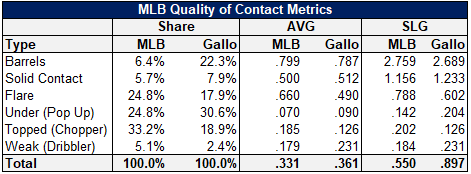
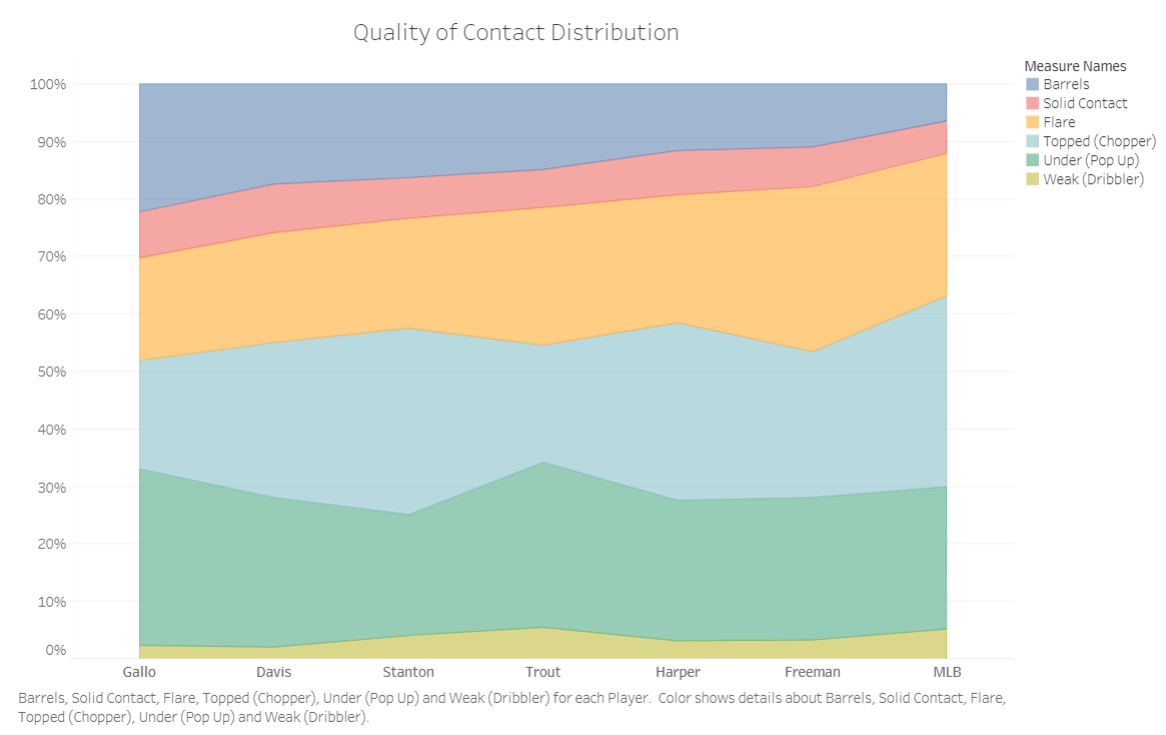
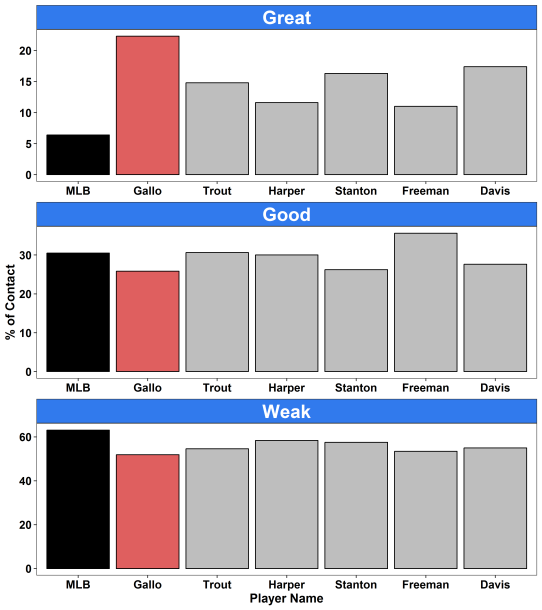

It’s so damn hard to put him in your lineup against a LH SP tho, he’s also a streaky hitter winning you some weeks and then going 2-20 the next. Depends on your type of league too, I just traded him in a large category league. I hope he adjusts like the article says but he was tough to own last year.
Thanks for the comment Will!
The crazy thing about Gallo is that, contrary to popular belief, he does not have a platoon split! Against lefties last year he had an 820 OPS compared to 804 against righties. It was a similar story in 2017, with an 841 OPS against lefties and 878 against righties. So I wouldn’t let pitcher handedness influence whether you start him or not.
Oh damn…. he actually hits best home vs LHP…. literally sat him vs every LHP starter last year… shit
Great article Nick. My league just reactivated and now I’m thinking about trading for him after reading this. Does his value go up in my 9×9 roto h2h league? AVG, HR, R, RBI, SB, XBH, TB, BB, OPS. Our league tends to favor the heavy hitters.
thanks,
Steve
Thanks for the kind words, Steve!
Those are interesting stat categories. Gallo will obviously be a drag on AVG, however, he should do very well on HR and BB, and above average on R, RBI, XBH, TB, and OPS. More plate appearances next season through hitting higher in the batting order will go a long way in cementing his value in a league like yours.